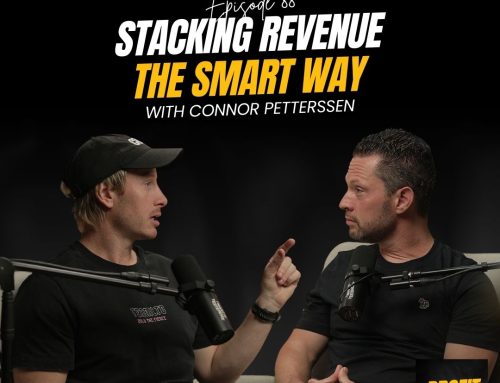How to Build an A-Player Gym Team and Lead with Confidence
In this episode of ‘Profit Made Simple’, we welcomed back one of our most popular guests, Mitch Phillips, owner of RFT. Over the past few years, Mitch has transformed his team and leadership approach, turning what was once a constant churn of staff into a stable, high-performing culture.
If you’ve ever struggled with finding, keeping, and leading great people, this episode is for you. Here’s how he built a strong, values-driven team and how you can do the same in your fitness business.
Episode at a Glance
- You get the team you deserve. Your team mirrors your leadership and standards.
- Stop abdicating and start leading. Create guardrails, mentorship, and rhythm.
- Hire for values first, then coach skills.
- Always be recruiting, not reacting.
- Onboard over 4 to 6 weeks with structure and checkpoints.
- Set clear floor KPIs to keep the job, and ceiling KPIs to unlock bonuses.
- Design your team structure so salary roles are viable.
- Lead through ownership, accountability, and communication.
1. Leadership First: The Team Follows You
Early in his journey, Mitch admits he avoided leadership. As a new father emerging from the chaos of COVID, he handed too much responsibility to one team member without direction or support. The result was churn and inconsistency.
What changed everything was a personal evolution. He worked through past trauma, engaged a mentor, and invested in a leadership coach who helped him refine his communication and self-awareness. He shifted from reacting to guiding.
“You can’t drag people up the mountain if you’re standing still. You have to climb first, then light the way.”
Your team will only rise to your level. If you want better coaches, become a better leader.
2. Hire for Values, Not Just Skills
In the early days, RFT hired anyone who could fill a session. Now, recruitment starts with alignment to the company’s and the owners’ personal values.
Skills can be taught, but character cannot. A technically sound coach with poor values will hurt your culture faster than a rookie who’s hungry to learn.
If you want a strong team, define what success looks like for each value. For example:
Value: Deliver an exceptional client experience. Success: Every member is greeted by name within ten seconds. Failure: Members walk in without acknowledgment.
When values are clearly defined, hiring and accountability become objective.
3. The RFT Hiring Process
Here’s the step-by-step system RFT uses to attract and select the right people:
Channels:
HealthyPeople, Seek, and direct outreach. Always keep a warm recruitment pipeline. Don’t wait until you’re desperate.
Screening Process:
- Application questionnaire: Filters effort and alignment.
- Phone screen: Tests communication and energy.
- Face-to-face interview: Focuses on values and culture fit.
- Paid trial: Candidate coaches a real session and experiences the culture.
Onboarding:
Successful candidates go through a structured 4-to-6-week onboarding process.
They shadow senior coaches, study systems through the RFT onboarding portal, and gradually take clients under supervision. Weekly check-ins and clear signoffs ensure readiness before they coach independently.
4. Onboarding that Sets the Standard
Those first 4 to 6 weeks shape culture, expectations, and future performance. Every new coach follows a playbook that covers:
- Session flow and coaching standards
- Client greeting and communication
- Accountability and reporting
- Business values and behaviours
If performance is poor during onboarding, it rarely improves later. Early clarity prevents future frustration.
5. Managing Performance with Process and Clarity
When an issue arises, RFT applies a simple leadership sequence before calling it a motivation problem:
- Clarity: Do they know what’s expected and why it matters?
- Capability: Have we trained and resourced them properly?
- Motivation: Only when 1 and 2 are clear do we coach attitude.
The philosophy is simple: process first, person second. Most performance issues are communication or system gaps, not laziness.
Example:
If a coach arrives late for a 5 a.m. open, the first step isn’t reprimand. It’s curiosity. “Everything okay this morning? I noticed you arrived close to start time. We need the gym open ten minutes early so clients can warm up. Can you commit to that from tomorrow?”
You lead with understanding, restate the standard, and reset expectations.
6. KPIs that Drive the Right Behaviour
RFT uses a two-tier KPI model: a floor (minimum standards) and a ceiling (performance bonuses).
Floor KPIs:
- Client hours completed — measure what’s delivered, not just booked.
- Monthly retention target — each coach aims for 98 percent.
- Values alignment score — based on observable behaviour.
Ceiling KPIs:
- Referrals generated
- Reviews captured
KPIs are public, reviewed weekly, and tied directly to accountability and reward.
7. Making Salary Roles Work in a Fitness Business
Many studio owners want to offer salary positions but worry about cash flow. RFT makes it viable through smart structure and semi-private delivery.
- Semi-private training increases members served per hour, improving efficiency.
- Workforce design mixes full-time and casual roles for flexibility.
- Seasonal thinking accepts short-term dips in profit during hiring phases in exchange for long-term growth and consistency.
You can’t scale without investing in people. Growth requires short-term sacrifice for long-term stability.
8. Growth is Seasonal
There were times Mitch and Vicky deliberately slowed the business to reset culture and rebuild standards. This wasn’t failure — it was strategic growth.
Just like nature, business goes through seasons. Spring, summer, autumn, winter. Expecting constant “spring” is unrealistic. Sometimes you must pause, reflect, and replant stronger roots.
Final Thoughts
Building a high-performing team isn’t about luck. It’s about leadership, systems, and alignment. Your team will reflect who you are and what you tolerate.
If you want better people, raise your standards first.
Your gym will only ever be as strong as the people within it and those people will only ever be as strong as the leader guiding them.







Leave A Comment